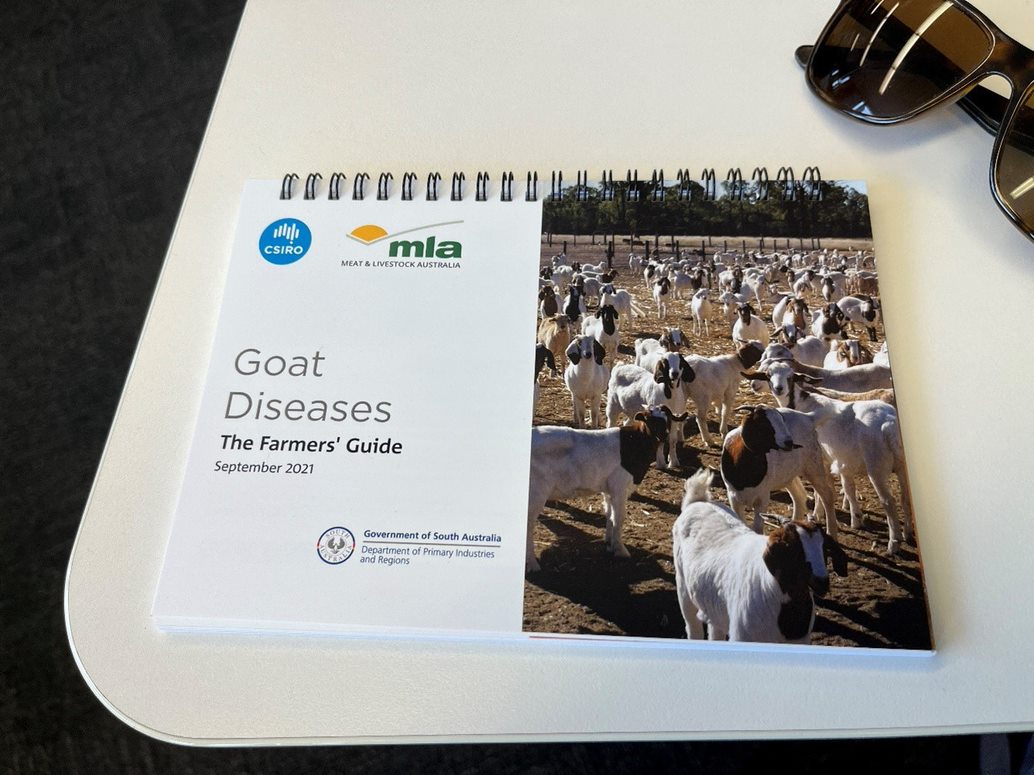
Get your copy of Goat Diseases – The Farmer’s Guide
Key points
- A new easy-to-read guide is available in hard copy and online to help goat producers recognise and manage goat diseases.
- On-farm livestock surveillance is critical to boosting Australia’s biosecurity systems.
The hard copy of the guide is made to fit in the glovebox of a vehicle and is tear-resistant and water-resistant.
Australian goat producers are reminded that hard copies of ‘Goat Diseases – The Farmers' Guide’ are available free of charge through MLA, and the digital version is available online at the MLA Goats Hub.
The practical guide is designed to help Australian goat producers recognise and manage goat diseases and ultimately boost biosecurity systems.
Supported by MLA, the guide is comprehensive and easy-to-read, available in both hard copy as a handy glovebox guide and also in digital format online.
The guide was principally developed by Emily Litzow, Nick van den Berg and Barton Loechel as part of a broader co-development team in the Goat Innovation Platform pilot group in South Australia.
The innovation group belonged to the farmer-led surveillance research initiative, part of the foot-and-mouth Disease (FMD) Ready Project*, which aims to strengthen surveillance and preparedness for an emergency animal disease outbreak using FMD as a model.
Improving livestock surveillance
CSIRO Research Scientist Dr Barton Loechel said supporting producers in improving livestock surveillance on-farm for endemic and emergency animal diseases was the catalyst for the guide.
“We engaged with producers directly about biosecurity surveillance and it was clear they wanted an easy-to-use reference guide specifically about goat diseases and pests,” Dr Loechel said.
“The cause, clinical signs, diagnosis, treatment and prevention for a comprehensive list of diseases is set out clearly and concisely in the guide.
“The pilot group supporting the development of the guide was made up of goat producers, industry representatives and veterinarians experienced with small ruminants and goats, and the guide was reviewed by goat only veterinarian, Dr Sandra Baxendell,” Dr Loechel said.
Comprehensive guide
The guide provides tips and tools to help producers establish an on-farm biosecurity plan, what to watch out for, how to manage a biosecurity incursion, and where to get help.
It also includes information relating to general animal health including drenching, vaccination, foot paring, kidding, body condition scoring and fit to load guidelines.
Dr Loechel said by monitoring livestock for diseases that already exist in Australia, particularly notifiable diseases, producers have a critical role in strengthening the nation’s biosecurity system.
“Farmers may not know exactly what the symptoms of FMD or many other exotic diseases would be if they were introduced into Australia, but if they see something unusual, then they have access to resources through the guide to get it checked out,” Dr Loechel said.
“Developing a working relationship with a local vet is also key to biosecurity surveillance for producers.”
Australia has been free of FMD since 1872 due to stringent pre- and post-border measures.
FMD is currently regarded as one of the most economically and socially devastating livestock disease threats to Australia, which could cost the country up to $50 billion over 10 years should a multi-state outbreak occur.
Access the digital version of the guide here. To secure a hard copy version of the guide, contact Joe Gebbels: jgebbels@mla.com.au
*The FMD Ready project is supported by Meat & Livestock Australia (MLA), through funding from the Australian Government Department of Agriculture, Water and the Environment as part of its Rural R&D for Profit program, and by producer levies from Australian FMD-susceptible livestock (cattle, sheep, goats and pigs) industries and Charles Sturt University (CSU), leveraging significant in-kind support from the research partners. The research partners for this project are the Commonwealth Science and Industrial Research Organisation (CSIRO), CSU through the Graham Centre for Agricultural Innovation, the Bureau of Meteorology (BOM) and the Australian Department of Agriculture, Water and the Environment, supported by Animal Health Australia (AHA).



